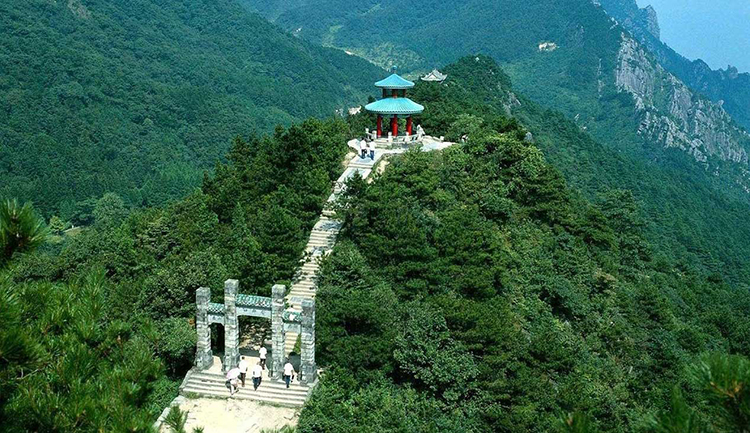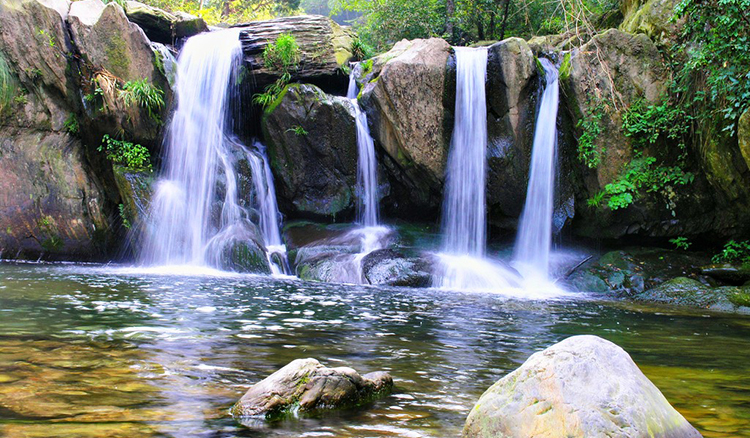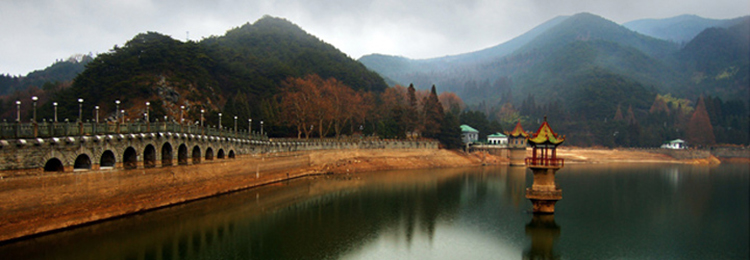Written by: Feng Yang
Posted on: August 04, 2016 |  | 中文
| 中文
Lushan National Park
Of all the Chinese sites inscribed on the World Heritage list, Mount Lushan has a somewhat special status, that of World Cultural Landscape. Located in the north of Jiangxi Province and on the southern bank of the middle reaches of the Yangtze River, the scenic spot has a total area of 302 square kilometers. Several cities not quite far from the mountain are so hot in summer that they are called “ovens”. Mount Lushan, however, is a cool oasis.
To know Mount Lushan, one must know something about its cultural background. When visiting it in 1928, Chinese scholar Hu Shi (1891-1962) wrote in his travelogue, A Trip to Lushan, that three historical sites in the mountain represent three tendencies. The first is the Eastern Woods Temple, which represents the general trend for Buddhism, an alien religion, to have assumed distinct Chinese characteristics. The second is the White Deer Cave, actually an ancient academy of learning, which represents the trend for the Song School of Confucianism, or neo-Confucianism, which would dominate Chinese thought for some 700 years after the 10th century. The third is the Guling Ridge that symbolizes the invasion of China by Western culture.
The Eastern Woods Temple lies at the northwestern foot of Mount Lushan. In the year 381 AD, the eminent monk Huiyuan was passing by Mount Lushan and put up on the mountain for a couple of days at the invitation of a fellow Buddhist. His chance changed the history of the mountain. Historical records say that Huiyuan made up his mind to stay and give up his plan to go to the south since he found Mount Lushan to be a peaceful place and good for the cultivation of one's inner world. The local magistrate had a temple built for him in the year 386. This new temple was to the east of the Western Woods Temple for his friend who had invited him to come. It was thus named the Eastern Woods Temple.
By Huiyuan's time, some 300 years had passed since Buddhism was brought to China. Even so, Buddhist scriptures were translated and lectured upon only in a rote way. Thus, Buddhism was limited only to the scholars’ circle and the upper class. Mysterious Learning, a metaphysical sect that had something to do with Buddhism, was quite popular at the time. It so happened that the Monk Huiyuan had a good ground in Buddhist philosophy, Mysterious Learning and Confucianism. When giving lectures on Buddhism, he integrated ideas of Confucianism and Mysterious Learning with those of Buddhism. As a result, those who had been confused about Buddhism came to understand it. More and more people came to the temple, and gradually the ideas of Buddhism began spreading across the country, and so did the reputation of the monk, Huiyuan.

In his 36 years on Mount Lushan, besides translating Buddhist scriptures, writing books on them and giving lectures, Huiyuan, with his knowledge, wisdom and open-mindedness, gathered a group of eminent monks and scholars around him. They set up the Pure Land Sect of Buddhism. According to this doctrine, as long as one recites the name of the Buddha, always keeps the "Western Paradise" in mind and gets rid of all human desires, one would be reborn in the Western Paradise after death. Since this Buddhist discipline is simple to practice, the Pure Land Sect became increasingly influential. Beginning with Huiyuan, Mount Lushan has been a most important Buddhist shrine in southern China.
Mount Lushan is also a holy shrine of Taoism, China's indigenous religion.
A Taoist monk named Lu Jingxiu had visited many famous mountains before he arrived in Mount Lushan in the year 461 and decided to stay. Then he had a Taoist temple built in the mountain. Those waterfalls, pine trees and bamboo groves made a very beautiful and peaceful environment for Taoist monks to practice their religion. Lu stayed on Mount Lushan for seven years. While there, he wrote about Taoism, transformed the organization of the Taoist hierarchy and established the Southern Sky sect of Taoism. Lu Jingxiu was canonized as Master Jianji (meaning "master of simplicity and tranquility"). The temple where he stayed has thus been called Jianji Temple.
In the year 405, a man who did not care for the vulgar taste of the secular world came to the foot of the mountain. He said in one of his best-known poems that a bird in the cage always misses the forest it used to stay in. He gave up his official post for a life of drinking wine, writing poems and doing farming in the fields. He died of illness and poverty, but never regretted his choice. This person was Tao Yuanming, a most prominent poet in ancient China. The moral integrity of this poet has been admired by intellectuals of later generations. Tao Yuanming was born here in Lushan. After he died, many scholars came from other places to live in seclusion like him.
Mount Lushan is a place of tranquility and also a place for introspection.

In the valley of Wulaofeng Peak, there stands the White Deer Cave Academy of Learning, one of the oldest and also one of the most influential institutions of learning in ancient China. It was Zhu Xi, one of the greatest scholars of Confucianism in the Song Dynasty (960-1279), to whom the regulation of the academy must be attributed.
Zhu Xi epitomized the Confucian school of idealist philosophy of the Song Dynasty and brought Confucianism to a new high. Until 1905, his interpretations of the classic works of Confucianism were compulsory textbooks for scholars intending to take part in imperial examinations for official posts. Zhu Xi was engaged in teaching for more than 50 years, when academies of learning were thriving. When he arrived in Lushan in 1179 to serve as an official, the White Deer Cave Academy of Learning had already become dilapidated. He had the academy that he rebuilt and bought farming fields for the scholars to do farming in their spare time, compiled textbooks and curriculums, set up rules for students and invited well known scholars to teach. He also collected a lot of classic books for the library. As a result, scholars came from all over the country and the academy became reputed as the best in the country. The goals, requirements, contents and method of the course of study established by Zhu Xi at the academy were to be followed by scholars of the later generations. The academy had witnessed ups and downs in the centuries until the mid-19th century when it was deserted.
Mount Lushan had witnessed its heyday from the fourth century to the 13th. There were as many as 500 Buddhist and Taoist temples on the mountain, and even in its less prosperous period, there were still as many as 300 temples. Different from other famous mountains, Lushan had a heavy ambience of culture and scholarship. It is Zhu Xi and his academy that made Lushan the mountain for Chinese intellectuals.
Chinese scholars or literati often wrote about mountains and rivers to vent their feelings, and many made friends with monks when they suffered frustrations in their political career. Mount Lushan was their favorite sanctuary. The Tang Dynasty poet Li Bai developed a liking for Taoism. Another Tang Dynasty poet, Bai Juyi, admired the noble characters of Poet Tao Yuanming. Both poets once had plans to build thatched houses to stay on Mount Lushan, and so did Zhu Xi, who was quite practical.
Chinese poets have written a lot of poems about various mountains. Of all these poems, only those about Mount Lushan have become household poems. Song Dynasty poet Su Shi wrote a poem on the wall of West Woods Temple, which goes:
Viewed horizontally, it's a ridge; vertically, a peak
And quite a different height from far or near
I can't recognize its true face because
I myself am on the mountain.
After making a trip to Big Woods Temple (Dalin), the Tang poet Bai Juyi wrote:
By the fourth month in the world
The flowers have already faded.
But the mountain temple peach buds
Have just gotten glorious.
I've deplore the loss of Spring
Couldn't find it anywhere,
Ignorant I moved right here.

Nowadays, the East Woods Temple and the Academy of White Deer Cave are still there; however, only the ruins of Jianji Temple remain. But there are many villas around Guling Ridge. Starting from the end of the 19th century, foreign missionaries began to lease land to construct villas there. It is estimated there are more than 600 villas in the styles of 18 countries. Catholic churches, Christian churches, Eastern Orthodox Church chapels and Islamic mosques mingle with the villas.
The UNESCO World Heritage Committee commented in 1996 that the Buddhist and Taoist temples along with the Academy of White Deer Cave, representing the Confucian school of idealist philosophy, blend effortlessly into a striking beautiful landscape. The landscape is of high aesthetic worth and well integrated with the spirit of the Chinese nation and its cultural life.
You may also like: